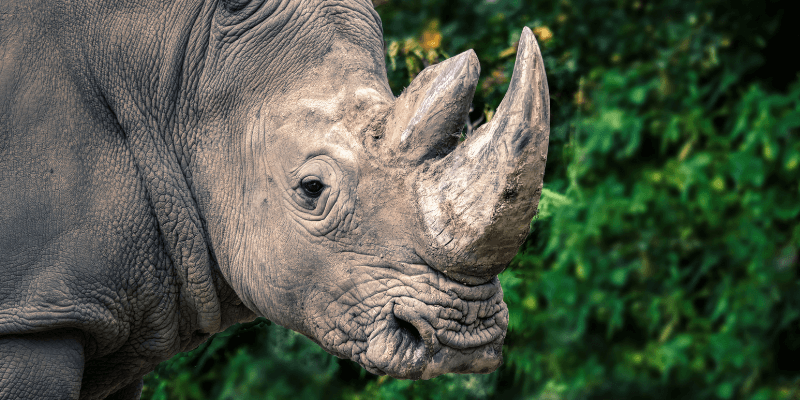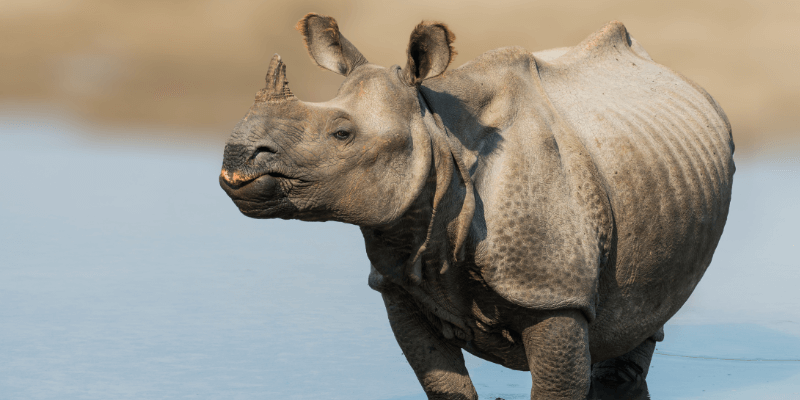Rhinos are among the world's most impressive and ancient animals. With their thick, armour-like skin and formidable horns, they look like creatures straight out of a prehistoric era. But what makes these majestic beasts so special, and why do they need our help now more than ever?
We’ve got the low-down on the fascinating facts behind your rhino questions! From their quirky habits to their fight for survival, we’ll also explore how you can become a part of their story.
The facts behind rhino FAQs
Let’s dive into fascinating facts about rhinos and uncover why their survival depends on urgent conservation efforts.What are rhino horns made of?
It’s a common misconception that rhino horns are bone. In fact, they are made of keratin, the very same protein that makes up our hair and fingernails! This means that, in a sense, they’re just giant, compacted tufts of hair.How many types of rhinos are there?
There are five living species of rhino today: the White and Black rhinos in Africa, and the Greater One-Horned, Javan, and Sumatran rhinos in Asia. Each species has unique characteristics, from the square lip of the White rhino (a grazer) to the pointed, prehensile lip of the Black rhino (a browser).How much does a rhino weigh?
Rhinos are true heavyweights! The White rhino is the largest species, with males weighing up to a staggering 2,300 kg, that’s more than 5,000 pounds!
How long do rhinos live?
Rhinos have a long lifespan, typically living for around 35 to 50 years in the wild.What animals do rhinos eat?
This is a trick question! Rhinos are herbivores, so they do not eat other animals.What do rhinos eat?
This depends on the species. As herbivores, rhinos eat plants. White rhinos are grazers, using their wide mouths to munch on grass. Black rhinos are browsers, using their pointy lips to grab leaves, twigs, and fruit from trees and bushes.Are rhinos dinosaurs?
No, rhinos are not dinosaurs! While they certainly look prehistoric, they are mammals and evolved millions of years after dinosaurs went extinct.How fast can a rhino run?
While they may look slow and bulky, don’t be fooled. A rhino can be surprisingly quick! How fast a rhino can run varies by species, but they can reach speeds of up to 55 km/h (around 34 mph) for short distances.Where do rhinos live?
Rhinos live in various habitats across Africa and Asia. African rhinos are found in grasslands and savannas, while Asian rhinos prefer dense forests and wetlands.What is a group of rhinos called?
A group of rhinos is called a crash. However, rhinos are generally solitary animals, so it’s rare to see a large crash together.Are rhinos aggressive?
Rhinos can be territorial and protective, especially when a calf is nearby. While they are not inherently aggressive towards humans, they will charge if they feel threatened. It’s always best to give these powerful animals their space.What noise does a rhino make?
Rhinos communicate through a range of sounds, from snorts and grunts to growls and roars. They also have a unique high-pitched squeak they use when they're excited.Do rhinos lay eggs?
Rhinos are mammals, which means they give birth to live young. A female rhino’s pregnancy is remarkably long, so ‘How long are rhinos pregnant?’, usually about 15-16
months.
Can rhinos swim?
Yes! Some species, like the Greater One-Horned rhino, are excellent swimmers and love to spend time wallowing in rivers and mud to cool down and protect their skin from the sun and insects.
The difficult truth: Why are rhinos endangered?
Now for the serious part. While we've just celebrated their unique charm, the reality is that rhinos are facing a severe crisis. Are rhinos endangered? The sad answer is yes, all species are under threat, with several being classified as critically endangered.Why are rhinos endangered?
The biggest reason is poaching for their horns. Despite being made of the same substance as our fingernails, rhino horn is highly valued on the black market. It is used in traditional Asian medicine, though there is no scientific evidence of any medicinal properties. It is also seen as a status symbol. This demand fuels an illegal trade run by organised criminal networks. This has led to a devastating decline in populations.How many rhinos are left in the world?
At the start of the 20th century, there were over 500,000 rhinos. Today, that number has plummeted to just over 27,000. How many white rhinos are left? The most numerous species, the southern white rhino, has a population of around 17,464, but poaching remains a constant threat. Meanwhile, the northern white rhino is functionally extinct, with only two females remaining.How can we protect rhinos?
The fight to save rhinos is a monumental challenge, but it's one we are winning. Rhino conservation efforts in countries like South Africa have shown incredible success. South Africa is a global leader in this field and is the only country in Africa that can claim to have more wildlife today than it had a century ago. This is thanks to dedicated conservationists, rangers, and community programmes working tirelessly on the ground.If you are passionate about a career in animal conservation and want to make a real difference, you can play a part in this vital work.
Animal Courses Direct offers a range of conservation courses, including the Level 3 Diploma in Sustainable Wildlife Conservation and Biodiversity Management. This qualification will provide you with the essential knowledge and skills you need to contribute to the protection of endangered species like the rhino.
You can also opt to gain hands-on experience with the four-week Wildlife Conservation Work Experience programme on a Game Reserve in South Africa. This is a once-in-a-lifetime opportunity to immerse yourself in a cross-section of ecosystems, learning about a variety of wildlife and conservation techniques directly from the experts.
If you are ready to turn your passion into a purpose and help secure a future for these incredible animals, explore the possibilities with Animal Courses Direct.

















